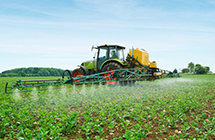 |
 |
|
| eNews • May 2019 | ||
| Promoting a Cost-Effective, Reliable and Competitive Transportation System |
||
 Fertilizer Availability Issues Could Linger Through Summer
Fertilizer Availability Issues Could Linger Through Summer
Fertilizer availability issues are creating a frenzy this spring. While various fertilizers are seeing limited availability, anhydrous ammonia is in the shortest supply. In some areas, the issue is so severe, retailers are rationing supply, only allowing farmers to fill a limited number of anhydrous ammonia tanks a day.
As the lines to get both dry and liquid fertilizer grow, Pro Farmer Inputs Monitor's Davis Michaelsen said the issue is a perfect storm this year with pent up demand. The wet fall last year meant not a lot of farmers were able to apply fertilizer in the fall. Then, a wet spring this year created similar issues in getting the product applied before planting. On top of that, flooding along major rivers and railways has created even more logistical hiccups in getting the product to retailers, magnifying the issues farmers and retailers are facing.
"So not only do you have that pent up demand looking for anhydrous, but you've also got areas impacted by floods, problems on the river, barge traffic has been a problem, and probably will continue to be," explained Michaelsen. "Meanwhile, in some areas you've got a very short window to get the supply because we have rain that rolls through every couple of days, and because of those weather patterns, that's just making problems even worse."
Michaelsen said anhydrous seems to be the biggiest supply issue this year.
"Suppliers can't just seem to keep up with deliveries, and not just because of logistics, but because of availability of the product, and that has forced a number of farmers to look for other options."
Farm Journal field agronomist and Crop-Tech Consulting's Ken Ferrie said farmers facing an anhydrous ammonia shortage are already forced to make alternative plans this season. He said most of the issues are showing up where farmers are able to get in the field, and additional problems will continue to occur once the rains shut off. Ferrie said if a farmer is facing a supply shortage in getting product to the field, it's time to think about alternative fertilizer plans.
"We talked about having plan A, B, C and D ready to go, and a lot of guys have moved from plan A, which was anhydrous, to plan B, which is dry urea," said Ferrie. "Now we're hearing reports due to the Mississippi transport issues, a lot of the warehouses are starting to run out of urea, as well. So, you want to be talking to your retailer to see what's available and what they can get to you as you're setting up this planting season."
Carroll County, Mo., farmer Adam Casner knew fertilizer could be an issue this year, so he made the decision early to switch to Plan B.
"The fertilizer shortage probably didn't affect us as much as a lot of people this year, because we had decided early on to switch a lot of acres over from using anhydrous ammonia to using a dry product," said Casner. "If we did use anhydrous, we went with a lot lower rate up front to make it go further, because with no one having anhydrous on their fields we knew it was going to be a struggle to get the product."
Casner said that plan is paying off when it comes to planting progress as he just finished planting corn on Sunday.
"We already had that plan kind of established, we're going to use more dry than liquid this year which really helped us speed up the planting process," he said.
Casner said they had issues getting the dry fertilizer product they wanted, but that outweighed not being able to apply fertilizer when they need.
Inputs Monitor is keeping an eye on the fertilizer logistical issues. Michaelsen fears this is an issue that could linger into the summer months.
"I'm afraid this is a problem that will stick with us through mid-June, because a lot of farmers know they can't get enough anhydrous as they want, so they will just come back and side-dress with some liquid," said Michaelsen. "So, we're going to have the identical demand push once we're post-emerge here for side-dress as we're experiencing right now on anhydrous, and I'm afraid supplies just aren't going to be able to keep up."
Ferrie said if farmers are weighing what Plan B and C should be, he said don't let your nitrogen program delay planting. Since it's so late in the season, he said get the seed in the ground first, then come back with an alternative plan to apply nitrogen later.
Source: AgWeb
Soy Transportation Coalition |
|
